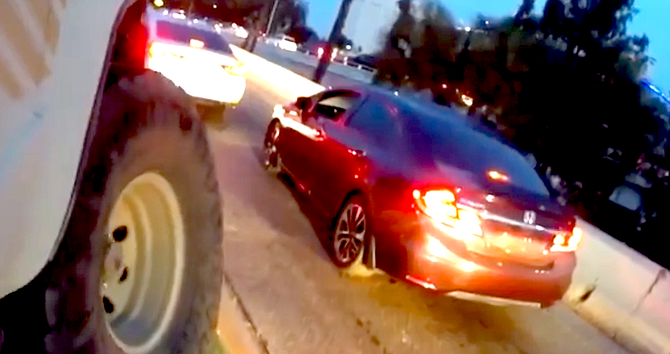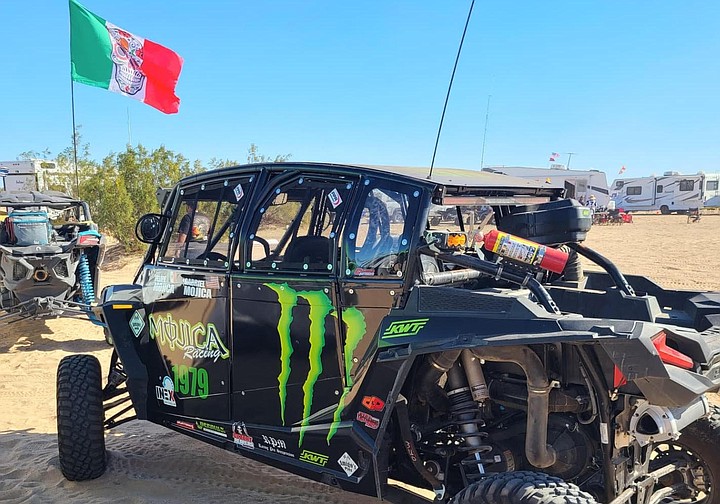 Facebook
Facebook
 X
X
 Instagram
Instagram
 TikTok
TikTok
 Youtube
Youtube

On November 22, Kathy Harren was stuck in traffic at the San Ysidro Port of Entry for 2.5 hours after returning from the Baja 1000 races. “We arrived at the border at 11 a.m.,” she said to me. “I enjoyed the wait because I was enthralled with the local people selling all the various items. It was an intimate, intense emersion into this most fascinating underbelly of Tijuana’s subculture.”

M.W. wasn’t as amused at the United States’ largest land-border port of entry last week. He forewarned his ‘San Ysidro Border Traffic / Wait Times’-Facebook group. “Remember guys; we have the Baja racers this weekend as well. I can imagine that might add to the already ridiculously long wait.” On November 18, he took a screenshot from the AccuWait app — which read, “San Ysidro Port …. Standard [lanes], 5 hours 7 minutes; Ready [lanes], more than 2 hours 13 minutes; Sentri, 19 minutes” — and posted it for all of his 10,800 fellow-group members on Facebook to see.

The longer-than-normal lines at the border began forming on November 8, as fully vaccinated people were allowed to cross from Mexico and Canada into the United States for nonessential travel. “It’s the holiday season, and some people with Visas haven’t been able to cross in two years,” commented Tony from San Diego. “[Traffic] will get worse before it gets better.” Pair the recent-border opening for nonessential travelers with the thousands of Baja 1000 fans and racers returning home — all make for mucho trafico — and gaviotas. “Gaviotas” which translates to seagulls or gulls — is slang for drivers that swoop into lanes as they cross back into the U.S. Gaviotas pay street vendors or willing participants to block traffic or move street barriers to cut in line.

“There were ‘line cuts,'” corroborated Harren, “[a] persistent man wanted money … to move the barriers and thus allowing us to cut the line. He had friends that would expedite us all the way up to the checkpoints. We said ‘no,’ but others took him up on his offer.”
Harren was part of a UTV racer’s pit crew at the 1227-mile race that started in Ensenada on November 15 and finished at La Paz on November 20.
Father-and-son racers Felipe Mojica and Gabriel Mojica trailered their raced out UTV, a 2021 Polaris RZR XP-1000 — down to the 54th-annual Baja 1000 race. They didn’t race, but the two assisted with their buddies’ pit crews, then returned to their El Cajon home through the Otay Mesa Port of Entry. “It was only 20 minutes for us,” Felipe said to me on November 30. “I saw a gang of people asking for money to put you in the front of the line, but I didn’t need it. We had Sentri passes, and it was only 20 minutes for us. The other racers returning to the U.S. said it took them two hours to get back.”
Felipe recounted to me when he recently returned from a different offroad race in their Denali SUV. “We were at the Otay border, and you know when I’m towing, I cannot slow down as fast like a normal car. [The gaviota] driver of a Hyundai tried to get in my way, and he got pushed over, and it ripped off his whole fender. Then the cop in Mexico said, ‘It’s your (the Hyundai driver's) fault; you were the one who tried to cut him off.’ Nothing happened to my truck, not a scratch.”
On November 17, Sintesis TV reported of the Mexican police arresting six gaviotas and 14 accomplices by the San Ysidro Port of Entry.
Felipe Mojica’s buddy, Miguel, said the “extra traffic” returning to San Diego was blamed on "the migrants. Yeah, I saw on the news a few days ago, they rushed the gates. It seems more honking and road-ragers are [evident] coming back nowadays, for sure… Back in June, around the same time as the Baja 500 races, an offroad truck climbed one of the cement barriers heading back home through the San Ysidro Port of Entry.”
“The reason the lines are long and are taking long is because they cannot open all the lanes due to the massive amount of Central American immigrants seeking asylum,” opined Marcia on the aforementioned Facebook page. “You may not see them, but they are camping out all through the river bed and El Chaparral.
"They don’t have enough officers to walk around and guard, as well as to have one in each lane. I’ve seen first hand how people try to run across and get knocked down by the officers as well as three to six officers on guard before reaching the checkpoint.”


On November 22, Kathy Harren was stuck in traffic at the San Ysidro Port of Entry for 2.5 hours after returning from the Baja 1000 races. “We arrived at the border at 11 a.m.,” she said to me. “I enjoyed the wait because I was enthralled with the local people selling all the various items. It was an intimate, intense emersion into this most fascinating underbelly of Tijuana’s subculture.”

M.W. wasn’t as amused at the United States’ largest land-border port of entry last week. He forewarned his ‘San Ysidro Border Traffic / Wait Times’-Facebook group. “Remember guys; we have the Baja racers this weekend as well. I can imagine that might add to the already ridiculously long wait.” On November 18, he took a screenshot from the AccuWait app — which read, “San Ysidro Port …. Standard [lanes], 5 hours 7 minutes; Ready [lanes], more than 2 hours 13 minutes; Sentri, 19 minutes” — and posted it for all of his 10,800 fellow-group members on Facebook to see.

The longer-than-normal lines at the border began forming on November 8, as fully vaccinated people were allowed to cross from Mexico and Canada into the United States for nonessential travel. “It’s the holiday season, and some people with Visas haven’t been able to cross in two years,” commented Tony from San Diego. “[Traffic] will get worse before it gets better.” Pair the recent-border opening for nonessential travelers with the thousands of Baja 1000 fans and racers returning home — all make for mucho trafico — and gaviotas. “Gaviotas” which translates to seagulls or gulls — is slang for drivers that swoop into lanes as they cross back into the U.S. Gaviotas pay street vendors or willing participants to block traffic or move street barriers to cut in line.

“There were ‘line cuts,'” corroborated Harren, “[a] persistent man wanted money … to move the barriers and thus allowing us to cut the line. He had friends that would expedite us all the way up to the checkpoints. We said ‘no,’ but others took him up on his offer.”
Harren was part of a UTV racer’s pit crew at the 1227-mile race that started in Ensenada on November 15 and finished at La Paz on November 20.
Father-and-son racers Felipe Mojica and Gabriel Mojica trailered their raced out UTV, a 2021 Polaris RZR XP-1000 — down to the 54th-annual Baja 1000 race. They didn’t race, but the two assisted with their buddies’ pit crews, then returned to their El Cajon home through the Otay Mesa Port of Entry. “It was only 20 minutes for us,” Felipe said to me on November 30. “I saw a gang of people asking for money to put you in the front of the line, but I didn’t need it. We had Sentri passes, and it was only 20 minutes for us. The other racers returning to the U.S. said it took them two hours to get back.”
Felipe recounted to me when he recently returned from a different offroad race in their Denali SUV. “We were at the Otay border, and you know when I’m towing, I cannot slow down as fast like a normal car. [The gaviota] driver of a Hyundai tried to get in my way, and he got pushed over, and it ripped off his whole fender. Then the cop in Mexico said, ‘It’s your (the Hyundai driver's) fault; you were the one who tried to cut him off.’ Nothing happened to my truck, not a scratch.”
On November 17, Sintesis TV reported of the Mexican police arresting six gaviotas and 14 accomplices by the San Ysidro Port of Entry.
Felipe Mojica’s buddy, Miguel, said the “extra traffic” returning to San Diego was blamed on "the migrants. Yeah, I saw on the news a few days ago, they rushed the gates. It seems more honking and road-ragers are [evident] coming back nowadays, for sure… Back in June, around the same time as the Baja 500 races, an offroad truck climbed one of the cement barriers heading back home through the San Ysidro Port of Entry.”
“The reason the lines are long and are taking long is because they cannot open all the lanes due to the massive amount of Central American immigrants seeking asylum,” opined Marcia on the aforementioned Facebook page. “You may not see them, but they are camping out all through the river bed and El Chaparral.
"They don’t have enough officers to walk around and guard, as well as to have one in each lane. I’ve seen first hand how people try to run across and get knocked down by the officers as well as three to six officers on guard before reaching the checkpoint.”
Comments